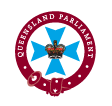-
Visit and learn
- Message from the Speaker
-
About Us
- A day in the Life of the Queensland Parliament
- The Executive Government of Queensland
- Officers of the Queensland Parliament
- The Origins of the Queensland Parliament
- The Queensland Parliament and Parliamentary Process
- Parliamentary Scrutiny via Parliamentary Committees
- The Queensland Parliament and the Financial Process
- The Queensland Parliament and the Legislative Process
-
The Queensland Constitution
- The Queensland Electoral System
- The Role of Parliament
- Separation of Powers
- Learn About Parliament
- Information For
- Visitors
- Visit the Public Gallery
- Visit our Gift Shop
- Have Your Say
- Get Involved
- Education and Learning
- History
- Heritage Collections
- Preservation of our Heritage
- Regional Sittings
- CPA Australia and Pacific Regional Conference
- Publications and Reports
- Speakers' Corner
- Opening of the 58th Parliament
- Parliamentary Annexe Reparation and Refurbishment
- Contact Us
The creation of Queensland as a separate colony
Prior to separation in 1859, the area now known as Queensland was governed from Sydney as part of the colony of New South Wales. Three Imperial (British) Acts—the Australian Constitution Acts of 1842 and 1850 and the New South Wales Constitution Act 1855 - allowed for the establishment of a separate colony of Queensland.
By Letters Patent and an Order-in-Council issued by Queen Victoria on 6 June 1859, Queensland was created as a separate colony, with its own Governor as the Queen’s representative and a bicameral legislature, i.e., a Legislative Council (Upper House) and a Legislative Assembly (Lower House) empowered to make laws "for the peace, welfare and good government of the colony". Governor Bowen arrived in Brisbane on 10 December 1859, read the Proclamation establishing the colony and it is from this date that Queensland became a separate colony.
The Queensland Constitution and other relevant Acts
In 1867, in order to consolidate the previous authorities, the Queensland Government passed the Constitution Act 1867, which incorporated the applicable sections of the previous New South Wales legislation, the Order in Council as well as other Queensland constitutional legislation passed between 1860 and 1867.
On 6 June 2002 (Queensland Day) the Constitution of Queensland 2001 came into effect. This statue consolidated the many Acts and other instruments which from 1867 comprised Queensland's constitutional law.
The Australian Constitution Act
In 1901, when the Queensland colony became a State within a Federal arrangement, the Queensland Constitution came under the influence of the new Commonwealth Constitution. Section 52 of the Commonwealth Constitution provided exclusive powers for the Federal Government along with other sections dealing with customs, coinage and military forces. Section 51 listed 39 powers – a number of which the States enjoyed as a "concurrent" legislative power with the Commonwealth. (However, Section 109 ensures that if State legislation is inconsistent with that of the Commonwealth’s, the latter’s legislation will prevail).
Changes to the Queensland Constitution
Alterations to Queensland’s Constitution can, in the majority of cases, be effected by the Queensland Parliament via the passage of legislation. However, several Queensland constitutional Acts contain "entrenched sections" which, as with the Australian Constitution, require a referendum as well as legislative amendment before changes can be made. These sections include the re–establishment of the Legislative Council, alterations to the three year parliamentary term, the Legislative Assembly’s status and the Office of Governor. In fact, a double entrenchment also applies because the referendum section which provides for the previous requirements cannot be altered unless first being approved by a referendum. Because of this "double entrenchment" these provisions remain in their original legislation and have not been legally incorporated into the Constitution of Queensland 2001 - although reference is made to them in the 2001 statute.
